With its green, swirled silver, or black leaves, the allure of Hoya krohniana can’t be denied.
You might think owning such a mesmerizing piece of nature would be a challenge, but it turns out this stunner is quite the low-maintenance houseplant!
Dive with us into the ultimate Hoya krohniana care guide. We’ll cover how it got recognized as a new species, its head-turning variegated leaves, ideal environmental conditions, and how to deal with common issues like yellow leaves.
We’ll even get into the secrets to making it bloom indoors.
(Shh, this is highly classified hoya information here.)
Table of Contents
Hoya Krohniana Plant Care Guide
History, Habitat, and Characteristics
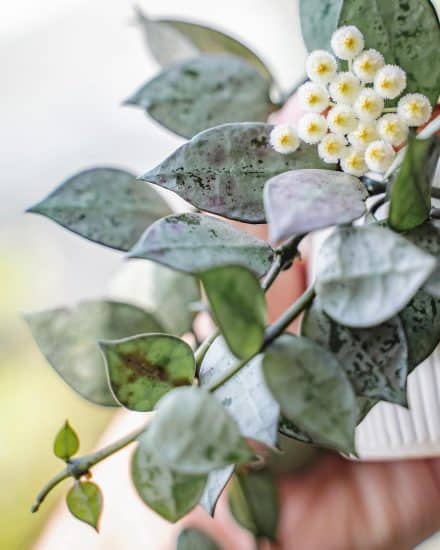
Originally from the Philippines, Hoya krohniana has made its way into homes worldwide, thanks to its beautiful variegated heart-shaped leaves and easy care. Who doesn’t love a low-maintenance, eye-catching plant?
Hoya krohniana is from the Apocynaceae family and part of the huge Hoya genus, which boasts over 300 species of tropical plants, including the Hoya lacunosa. Known as “wax plants” because of their thick, waxy leaves, these plants are famous for their unique foliage and stunning blooms.
Before it was classified as its own species, Hoya krohniana used to be known as Heart-leaf lacunosa.
Did you know: It can be hard to tell certain species of hoyas apart, including these two, but botanists do it using parts of the flower like the corolla and corona, and even pollinia, or pollen masses.
Dale Kloppenburg and Dr. Simeona V. Siar identified Hoya krohniana as a separate species in 2009. Good job studying those flower bits, botanists.
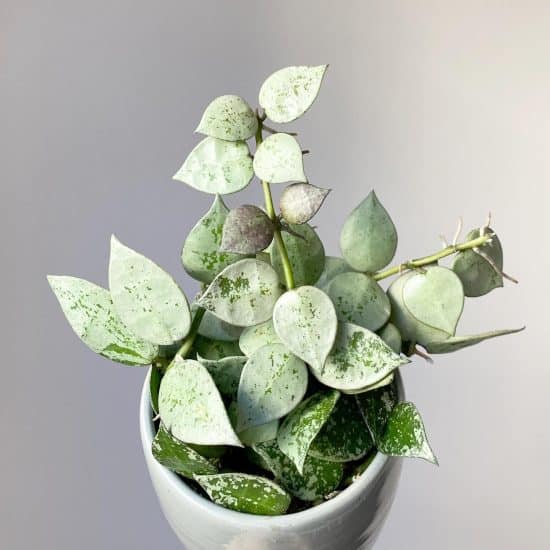
In the heart of the dense rainforests of the Philippines, Hoya krohniana grows as an epiphytic plant. That means it doesn’t need soil to thrive; instead, it attaches itself to trees and other plants, absorbing nutrients and moisture from the humid air through its aerial roots.
This characteristic actually comes in handy when growing your hoya plants since they adapt well to a variety of different potting soil.
Its thick leaves help it to retain moisture, making it ideal for indoor conditions. And who wouldn’t want to show off those gorgeous green and white speckled leaves in a hanging basket?
Varieties
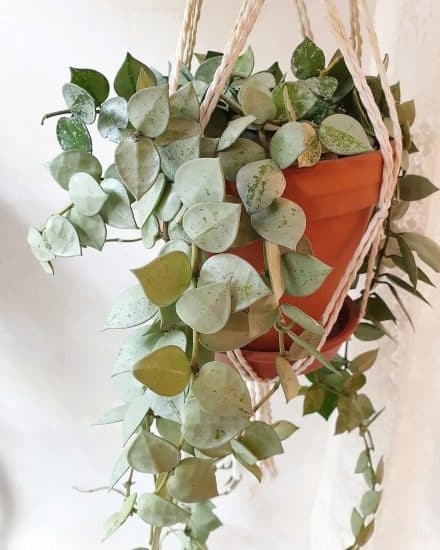
There are several different varieties of Hoya krohniana, including Hoya krohniana ‘Silver’ and Hoya krohniana ‘Black.’
Hoya krohniana ‘Super Silver’ and Hoya krohniana ‘Eskimo’ are both other names for Hoya krohniana ‘Silver’ — but they’re all the same plant. Some people use names like ‘Super Splash’ to denote extra-variegated versions. It’s green with, you guessed it, “splashy” white or silver speckles that can sometimes cover almost the entire leaf.
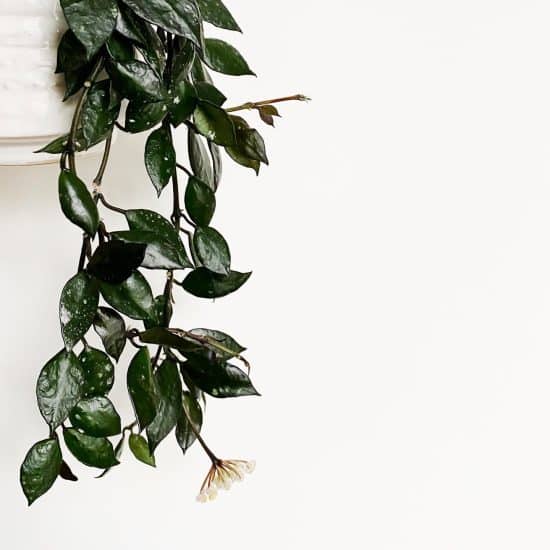
Hoya krohniana ‘Black’ has small, pointy leaves that mature to a stunning deep purple, appearing almost black.
Light
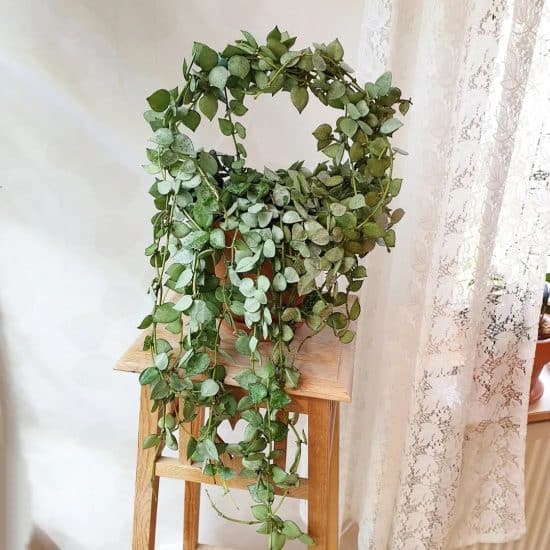
In the wild, Hoya krohniana basks in the rainforest understory, climbing and trailing along tree branches. So, it’s no surprise this hoya is perfectly happy in low-light conditions or partial shade.
Bright indirect light is the way to go for Hoya krohniana, with a hint of direct thrown in. Do you have an east-facing window? Perfect! Your hoya will absolutely love soaking up the bright direct light from gentle morning sun coming through, followed by indirect light for the rest of the day.
Tip: Lots of light is essential for encouraging your hoya to bloom.
But what if your Hoya krohniana isn’t getting enough indirect sunlight? You might see signs like slow growth or etiolation, when the plant reaches out for any light it can find, sort of like it’s begging for some sunshine.
If you can’t move it closer to a window, you can give your plant a little boost with a full-spectrum LED grow light. Not only are these lights energy-efficient and great for easy propagation (which we’ll cover later), but they’ll also help your plant soak up the rays it needs to thrive.
Too much direct sun, on the other hand, can be a real mood-killer for your plant. If you start to notice leaves turning brown and crispy or losing their vibrant color, it’s time to step in and save the day. You can move your plant further from the window or use a sheer curtain to help filter out some of that intense sunlight. Crisis averted!
Water
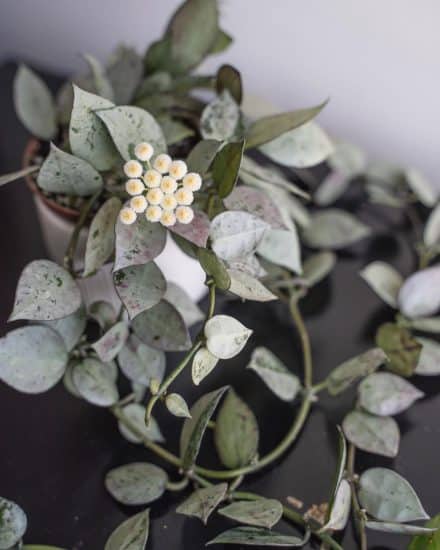
The perfect amount of water for Hoya krohniana depends on a few things, like the type of pot and medium it’s in, humidity levels, and temperature.
You should always let the soil tell you when your plant needs some H20 — stick a finger in the pot and water when the mix is dry a few inches down.
In general, you can aim to water every two weeks, since this houseplant can handle a bit of drought. Just remember, it’s better to underwater than overwater this plant.
So, how do you know when your Hoya krohniana needs a drink? Aside from soil wetness, keep an eye on its leaves. Wrinkling is their way of saying, “Hey, I’m thirsty!” When that happens, give your plant a good soak, ensuring the soil is evenly saturated and excess water drains out properly.
Now, let’s talk about what happens when things aren’t quite right. Not enough water can lead to leaves wrinkling and maybe even curling up. If you spot this, don’t worry — just increase your watering frequency and remove any sad-looking leaves to keep pests away.
On the other hand, too much water can cause your Hoya krohniana’s leaves to turn yellow and eventually fall off (poor things). This usually happens when roots can’t breathe properly because they’re drowning in waterlogged soil.
If that sounds familiar, let the soil dry out before watering again.
Temperature and Humidity
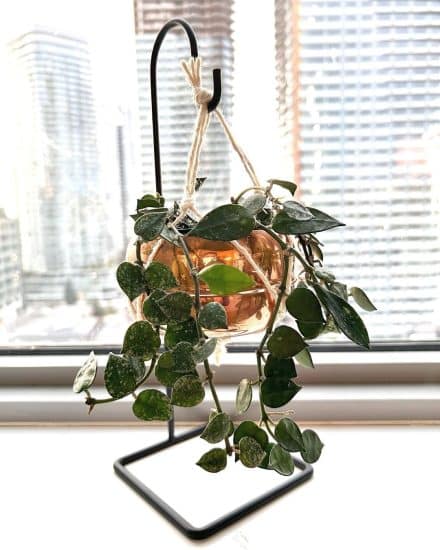
Creating the perfect environment for your Hoya krohniana ‘Silver’ or ‘Black’ is essential to help it flourish . . . and maybe even bloom! Let’s start by looking at the temperature and humidity requirements to keep your hoya happy and healthy.
As a tropical plant, your hoya prefers temperatures in the range of 65-80°F (18-27°C). Although it can adapt to slightly cooler temperatures, prolonged exposure to anything below 50°F (10°C) can cause the plant to suffer. Keep it away from cold drafts, windows, and doorways that might let in chilly air. A heated room is ideal during winter months.
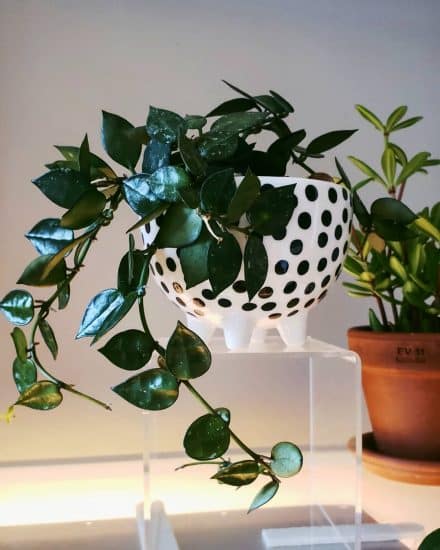
Similarly, this plant appreciates good air circulation, but doesn’t like to be exposed to high temperatures for extended periods. If you notice the leaves looking yellow, wilted, or drooping, it might be an indication that your hoya is getting too much heat.
Hoya krohniana loves a high-humidity environment, which helps mimic its natural tropical habitat. Aim for a humidity level of 50-60%. Signs of too little humidity include brown leaf edges or leaves curling inward, while too much humidity may cause mold or mildew growth. Rotting roots can also be a sign of excessive moisture.
Our humidity tips:
- Use a humidifier (obvious, but effective!).
- Place your plant on a tray filled with water and pebbles. The water will evaporate, naturally increasing the humidity around it.
- Group plants close together to promote higher humidity through a process called transpiration.
While misting the leaves can help raise humidity temporarily and remove dust or pests, it’s not a long-term solution. If you do mist your plant, remember to wipe it down afterward to avoid potential issues with mold or mildew.
Soil and Planting
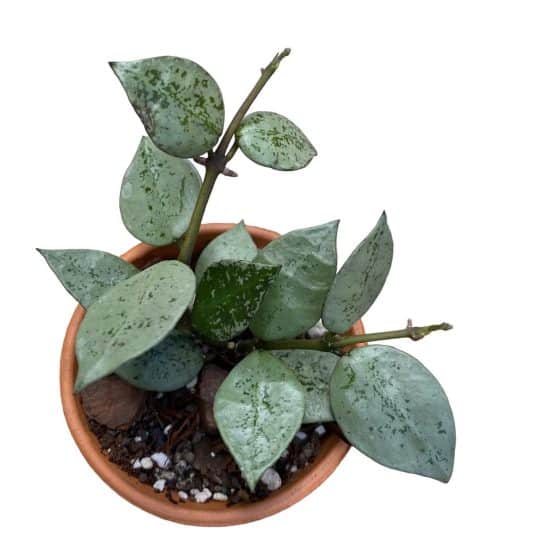
Hoya krohniana thrives in a well-draining epiphytic mix that gives it just the right amount of moisture and nutrients.
You can keep it simple and use high-quality regular houseplant soil with some coco coir and perlite mixed in to aid drainage.
If you’re feeling fancy, throw in some sphagnum moss, charcoal, pine bark, fir bark, or tree fern. These elements work together to create an airy and nutritious environment for your hoya to grow healthy and strong.
Choosing the wrong soil mix can lead to rotting roots, slow growth, and wilted leaves. If you see yellowing leaves, a weak root system, and a lack of new growth, it might be time to reevaluate your potting mix.
Fertilizing
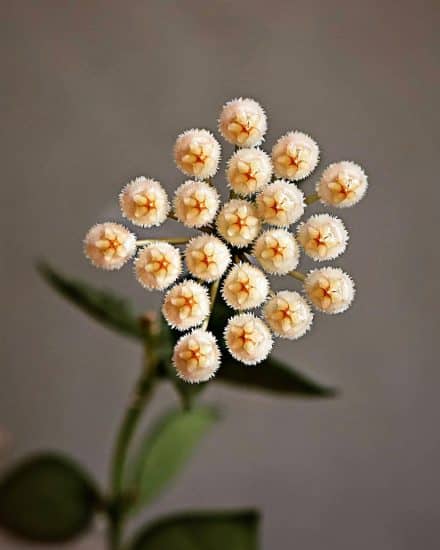
Mix in a slow-release fertilizer with your potting mix to give your Hoya krohniana nutrients. Additionally, apply a diluted fertilizer solution twice a month.
Don’t fertilize in the winter, since your hoya will be dormant and unable to use the nutrients. Plus, over-fertilizing your Hoya krohniana can cause burned leaf tips, a buildup of fertilizer salts around the pot’s edges, and stunted growth.
Accidentally over-fertilized? All is not lost! Flush the soil with water to remove excess fertilizer salts. Be sure to dial back the frequency and strength of your fertilizer applications in the future.
Repotting
Hoya krohniana does well in a smaller pot with sphagnum moss (or a more environmentally sustainable medium, like coco coir), allowing it to grow in compact clusters. You’ll have to repot once every two years or so, when the roots start to outgrow the current pot.
Hot tip: A rootbound hoya is more likely to bloom. If you’re lucky enough to get flowers, don’t prune the flower peduncles (spurs springing from the leaf and stem) after they’ve bloomed, since they’ll produce more flowers later!
When repotting, choose a container one size larger than the original and ensure it has proper drainage holes to prevent root rot.
Hoya Krohniana Propagation Guide
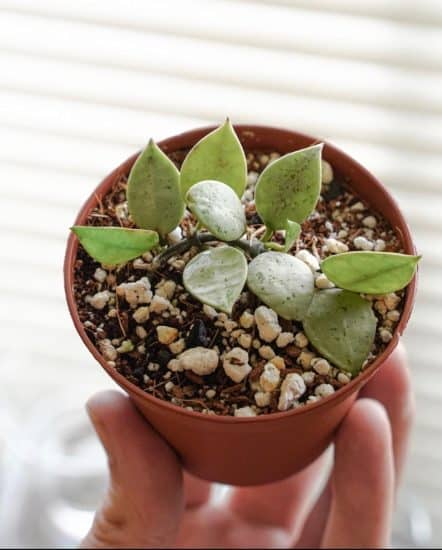
The easiest way to propagate Hoya krohniana is by cuttings. You’ll need both a leaf and a stem or aerial root for this process.
Propagating Hoya krohniana by cuttings:
- Scope out your mother plant and look for those long aerial roots. These bad boys will become the new plant’s root system, so pick a good one! Oh, and make sure it’s got some healthy heart-shaped leaves attached and at least one node, too.
- Get snippy with it by using sterilized gardening shears or a sharp knife to trim the aerial root. Leave a bit of the stem connected to the aerial root — it’s like the plant’s lifeline! Dip the cut end into rooting hormone powder to encourage faster root growth.
- Moss it up by preparing a container filled with sphagnum moss. Gently place the cutting in the container, making sure the aerial root and lower stem are all snuggled up with the moss.
- Keep it damp, not drenched, by misting the moss with water. A nice humid atmosphere with indirect light will help your cutting grow those precious roots. When they get to be a few inches long, repot in our recommended soil mix above.
Our propagation tips:
- For a cool and stunning look, mix it up by potting silver and black Hoya krohniana plant varieties together in the same pot. You’ll have an eye-catching combo that’ll make your fellow plant lovers green with envy!
- If your cutting isn’t growing as well as you’d like, check to see if it’s sitting in a pool of water or super wet moss. Overwatering can put a damper on root growth, so keep things balanced.
Common Issues
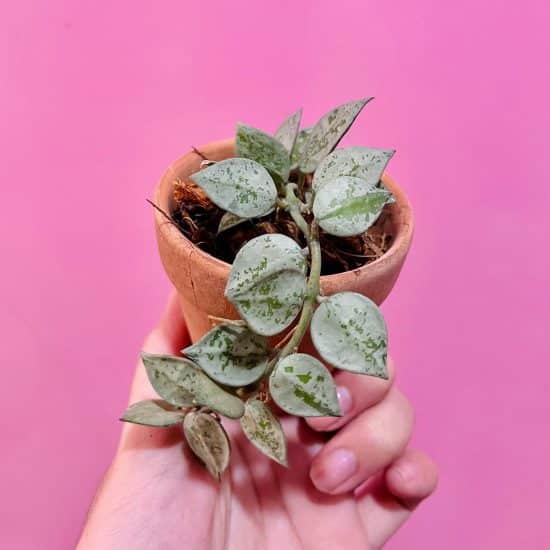
Hoya krohniana can run into the same types of issues as other hoyas, including yellow and wrinkled leaves.
Yellow Leaves
Noticed some yellow leaves on your Hoya krohniana? Usually, this means the plant has been getting a bit too much water. Imagine if you had to stand in waterlogged shoes all day . . . not fun, right? It’s the same for your plant!
To sort this issue out, let the potting soil dry out an inch or two down between waterings. Don’t forget to ensure your pot has proper drainage so the excess water can escape. Also, keep an eye on the light your plant gets — too little can cause more yellowing.
Wrinkled or Flat Leaves
Now, if you’re seeing wrinkled or flat leaves on your Hoya krohniana, your plant is giving you a hint that it needs a bit more water. Remember, use the finger test: Poke your finger into the potting soil and, when the top couple of inches are dried out, give your plant a healthy drink.
Don’t forget to check its lighting situation, too, as inadequate light can also contribute to those sad, flat leaves.
Pests and Diseases
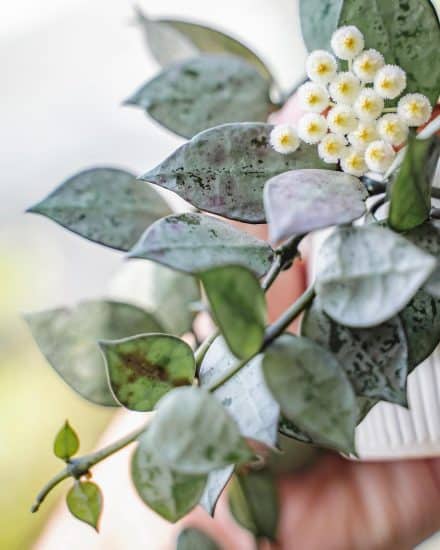
We’ll tackle two common problems we see quite often with these guys: mealybugs and root rot.
Mealybugs
Mealybugs can be a real headache for hoya owners, especially when your plant is still a young cutting. They’re these tiny, white, cotton-like critters that love to hang out in the cozy corners of your plant’s leaves and stems.
To figure out if mealybugs have invited themselves over, look for the little cotton-ball-like clusters on your hoya’s leaves. They might even leave behind a sticky residue called honeydew.
Solution: If you catch these party crashers early enough, you can usually just flick, brush or wash them away with water. But if they’re stubborn (and they often are), no worries – just mix some dish soap and water, or apply diluted neem oil to the stems and leaves (both sides, please).
Root Rot
Root rot is another sneaky problem that can plague your Hoya krohniana, as well as many other indoor plants. It usually happens when your plant gets too much water or doesn’t have proper drainage, and then you’ve got soggy, unhappy roots on your hands. Aerial roots can also suffer.
To identify rotting roots, keep an eye out for yellowing or wilting leaves, a funky smell coming from the soil, and roots that are mushy, brown, or black instead of healthy white.
Solution: First, gently remove your hoya from its pot and snip away any gunky roots with clean, sterilized scissors. Then, give the pot a thorough cleaning and disinfection (or grab a new one) and repot your plant in fresh, well-draining soil with good drainage.
Preventing root rot comes down to proper watering and drainage. Don’t overwater your plant, and ensure its pot has enough drainage holes. You might even want to add some perlite, pumice, or LECA to the soil mix for better aeration and drainage.
Keep tabs on your plant’s moisture levels and only water when the top inches of soil feels dry.
Conclusion
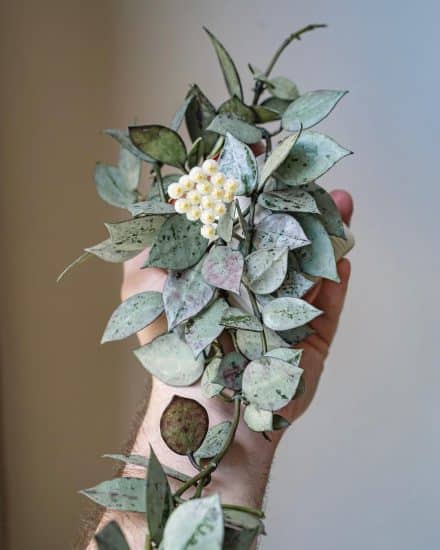
Hoya krohniana ‘Silver’ and ‘Black’ are gorgeous, easygoing plants, whether you pair them together in one pot or keep them separate. Their delightful variegated leaves and adaptability make them not only easy plants to keep indoors, but some of our favorites.
We hope you found our Hoya krohniana guide helpful and informative! If you have any questions or concerns that we didn’t address, reach out on Facebook or Twitter. And if you found this guide useful, share it with your friends and fellow plant lovers.
Happy growing, and take care!
FAQ
Is Hoya krohniana ‘Black’ rare?
Hoya krohniana ‘Black,’ also known as the ‘Black Version,’ may be considered somewhat rare compared to other more common hoya varieties. However, its striking dark leaves and low-maintenance appeal are making it increasingly popular among plant enthusiasts and more accessible in the houseplant market.
How do you care for a Hoya krohniana ‘Eskimo’?
Caring for Hoya krohniana ‘Eskimo’ is a breeze, since it shares similar care requirements with other hoya varieties. Provide well-draining soil, maintain moderate temperatures (65-80°F / 18-27°C), and aim for 50-60% humidity. Make sure it’s in bright light (mostly indirect), and water when the top few inches of soil are dry. During the growing season, apply diluted liquid fertilizer twice a month.
Does Hoya krohniana bloom?
Yes, Hoya krohniana does bloom! When you create the optimal conditions for your plant (lots of light!) and it feels content, it will reward you with delicate, fragrant white flowers. Just remember to be patient, as it might take a while for your plant to produce these lovely blooms.
If you’re having trouble getting your Hoya krohniana blooming, you’ll want to also make sure you don’t have it in a pot that’s too large.
What is the difference between Lacunosa Silver and Krohniana Silver?
Hoya lacunosa ‘Silver’ and Hoya krohniana ‘Silver’ are two distinct hoya species, although they share some similarities in appearance and care requirements. The primary difference lies in their leaf patterns and shapes.
Hoya lacunosa ‘Silver’ has smaller leaves with a more pronounced silver speckling compared to Hoya krohniana ‘Silver,’ which has larger, uniquely heart-shaped leaves adorned with green and white speckles.


